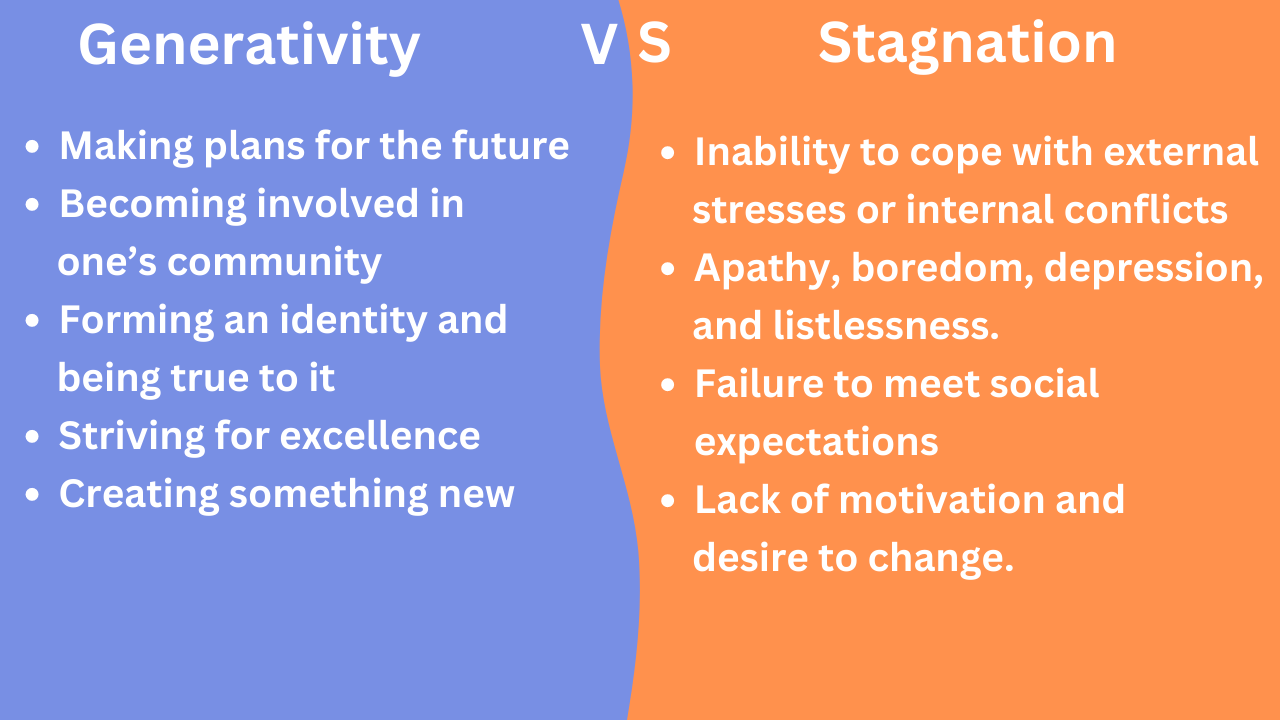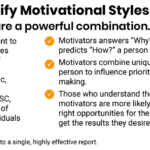Middle age is a time when many people start to reflect on the legacy they will leave behind. This is the focus of the seventh and final stage of Erik Erikson’s theory of psychosocial development: Generativity vs. Stagnation.
According to Erikson, this stage typically occurs between the ages of 40 and 65 and is characterized by a focus on creating or nurturing things that will outlast the individual. This can include children, a career, or contributions to the community.
But for some, this stage can be a time of stagnation and a feeling that their lives lack meaning or direction. We will explore how to navigate this stage of life to find fulfillment and satisfaction. Read on to learn more about generativity versus stagnation and how people can use it to impact the world positively.
Examples of Generativity in Our Lives
- Generative parenting behaviors include providing children with opportunities to learn, grow and explore.
- Generative activities in the workplace, such as taking the initiative, leading projects, and creating new products or services.
- Generative solutions in communities and societies include creating policies and programs that promote social equality and environmental sustainability.
Examples of Stagnation in Our Lives
- Parents who do not provide their children opportunities to grow and explore perpetuate stagnant behaviors.
- Stagnant workplace activities, such as failure to take the initiative.
- Stagnant solutions are proposed by communities and societies, such as failing to address social or environmental issues.
The Gifts of Generativity Over Stagnation
- Generativity creates a stronger sense of purpose for you and your communities.
- Generativity stimulates creativity and innovation within society.
- Generativity encourages collaboration and cooperation between individuals, organizations, and governments.
- Generativity promotes your growth through exploration and learning from new experiences.
The Penalties of Stagnation are Many
- Stagnation limits potential growth as it discourages exploration.
- Stagnation needs more incentives for innovation.
- Stagnation suggests that resources are finite, thus discouraging collaboration.
- Stagnation prevents progress toward desired outcomes.
How is Generativity Closer to Personal or Professional Goals?
Generativity can be a step closer to a person’s personal or professional goals in several ways:
Idea Generation
Generativity is closely linked to personal and professional goals because it helps us generate ideas that can lead to meaningful action. It enables us to think creatively, bringing innovative solutions to problems or turning ideas into tangible results.
Problem-Solving
Generativity plays a large role in problem-solving by allowing us to develop new solutions or approaches for tackling them. By cultivating the ability to think outside the box, we can explore alternative options and see how seemingly unrelated things are connected.
Innovation
Generativity promotes innovation in personal and professional settings by enabling people to discover fresh ways of approaching tasks or projects. Through generative processes, people can push themselves beyond their comfort zones, experiment with different ideas, and ultimately come up with original solutions.
Personal Growth
The act of generosity encourages us to achieve our short-term and long-term goals by developing our talents, skills, and knowledge.
A generative activity is like brainstorming ideas, researching topics relevant to our interests, or trying something challenging but rewarding like starting a business.
Self-Expression
Generativity provides an outlet for self-expression whereby people can express themselves through creative work rather than words alone. The power of this form of communication lies in the ability to convey emotions on a deeper level without language barriers or other factors getting in the way.
Empowerment
Finally, generativity can help people feel good about themselves and help groups of people work together. When people are generative, it means they can lead and make decisions based on their new ideas. This makes people feel empowered and accomplished.
How is Stagnation Not Closer to Professional or Personal Goals?
Stagnation is not a degree closer to a person’s career or personal goals because it can have several negative effects that impede progress toward achieving goals.
Lack of Progress
Stagnation can greatly hinder progress toward professional and personal goals. When a person fails to move forward, they become stuck in a rut with no new opportunities.
The lack of progress can lead to stagnation, where ideas remain stagnant, and the same processes continue without innovation consideration. Ultimately, this can hinder someone’s ability to reach their goals since it prevents them from developing their skills and knowledge.
Lack of Innovation
Without innovation, there is no progress made toward professional or personal goals. Stagnation tends to breed a lack of innovation since people become comfortable with the status quo and do not take the time to think outside the box or consider alternative solutions to problems. This can result in complacency.
Reduced Competitiveness
In today’s increasingly competitive world, stagnation can lead to reduced competitiveness compared to other organizations or individuals pushing ahead with innovative ideas and strategies that create sustainable success over the long term.
Lack of Motivation
Not only does stagnation prevent progress toward professional or personal goals, but it also hinders motivation levels. Low morale often follows when people feel like they are stuck in place.
Lack of Personal Growth
Stagnation prevents personal growth because it prevents individuals from expanding their skill set by learning new things or taking on different roles. Many people feel unfulfilled professionally and personally without these opportunities due to stagnation.
Resistance to Change
With stagnation comes resistance; some employees may fight against change because they feel like change could negatively affect them or cause disruption within the workplace due to unforeseen consequences.
Thus, this resistance makes it hard for organizations to implement any kind of progress due to a lack of organizational buy-in, which leads back to the cycle we started with.
How Does Generativity Help You Achieve Your Goals?
Increases Motivation and Drive to Achieve Goals:
Generativity creates a sense of purpose and motivation to work towards your goals. Generativity helps you achieve your goals by providing a sense of purpose and direction. It encourages you to take the initiative and strive for success, prompting you to stay focused on your goals.
As you become invested in something meaningful, the feeling of generativity can fuel your motivation and drive to reach those objectives. Through generativity, you can create goals aligned with your values and beliefs, making them easier to attain as you are more meaningful to you.
When you feel that a task has purpose or significance beyond just ourselves, it provides an extra spark of energy that can help propel you forward as you chase your ambitions.
Encourages Creative Thinking and Exploration of Different Paths Towards Achieving Goals
Generativity allows you to believe outside the box and consider alternative solutions to reach your goals. It allows for the exploration of different paths toward achieving any given goal.
Generativity encourages the development and implementation of innovative strategies which help keep the process fresh and exciting. This can be helpful when trying to come up with new solutions to problems or finding a way around obstacles to achieve your desired outcomes.
By encouraging out-of-the-box thinking, generativity allows you to think differently about reaching your goals, providing more flexibility in approach.
In addition, generativity-minded people often take risks which can lead to unexpected rewards such as greater success or personal satisfaction when the right risk pays off.
Increases Self-Efficacy by Reaffirming Your Abilities
Generativity helps to build confidence in your mastery to achieve your goals. It increases self-efficacy by reminding yourself that you have all the power within yourself needed to reach any given goal.
When you have faith in your capabilities, it gives you the strength to stay focused on whatever result you are pursuing instead of becoming demotivated or overwhelmed along the way.
Beyond boosting, self-confidence levels, engaging with generative tasks can also give insight into how much potential lies within you as an individual. This awareness enables you better equip yourself for future endeavors toward achievement and success.
When combined with other resources, such as effective planning techniques and positive self-talk, generativity further bolsters one’s ability to reach goals without succumbing to pressure from external sources.
How Does Stagnation Hinder you From Reaching your Goals?
Stagnation can have a significant impact on your ability to reach your goals. When you are in a state of stagnation, it can hinder you in several ways.
Diminishes Drive and Motivation to Achieve Goals
Stagnation diminishes the drive and motivation to achieve the goals you set for yourself. You become complacent and are no longer motivated to push yourself beyond your comfort zone. This leads to procrastination, which is often detrimental when it comes to reaching goals.
Discourages Creative Thinking
It can also discourage creative thinking, making exploring further paths toward accomplishing your goals difficult.
Without the opportunity to think outside the box and be imaginative about how you could achieve your goal, you may find yourself stuck in a rut with little hope of progressing any further.
This is especially true when dealing with complex tasks or problems that require original solutions and innovative ideas.
Decreases Self-Efficacy
Stagnation can have a negative effect on self-efficacy, the belief that one is capable of meeting any goal or challenge. Failure to progress toward goals leads to feelings of inadequacy, which can be difficult to overcome.
When individuals feel like they are not making progress, they may become overwhelmed and give up on tasks as they feel they cannot accomplish them. This feeling of helplessness often leads to a lack of motivation and an overall decreased self-confidence.
Final Thoughts
Generativity vs. stagnation is an incredibly important concept to consider when looking at personal and professional goals.
Generativity helps us challenge ourselves, encourages creative thinking and innovation, provides us with a sense of empowerment, and allows us to explore different paths toward achieving our goals.
On the other hand, stagnation can lead to a lack of progress or motivation, reduced competitiveness and creativity, and hindered personal growth. It is essential that we nurture generative behaviors to reach our fullest potential and realize our goals.




